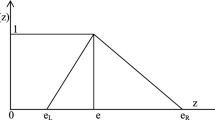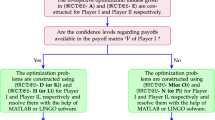Abstract
The hesitant fuzzy set (HFS) is a very fruitful mathematical approach to deal with uncertain or imprecise information. In this work, we consider a multi-objective linear production planning (MOLPP) problem in which multiple decision makers pool resources to make various products and analyze them with the help of cooperative game theory. It can be formulated as a mathematical programming problem with triangular hesitant fuzzy (THF) parameters. The main aim of this paper is to analyze the MOLPP problem in THF environment. In view of realistic sense we choose the coefficients of multi-objective linear production planning game (MOLPPG) as triangular hesitant fuzzy numbers (THFNs), and hereby it is referred to as THF-MOLPPG. The THF-MOLPPG is converted to fuzzy MOLPPG by taking an average aggregation operator (AAO) of the THFNs. Thereafter we consider \(\alpha \)-cut of a fuzzy number to obtain MOLPPG with interval parameters. Two approaches, namely weighted sum method (WSM) and extended technique for order preference by similarity to ideal solution (TOPSIS), are chosen to obtain the optimal strategy and payoff vectors of the players to the MOLPPG. For solving MOLPPG, we apply WSM and extended TOPSIS by considering the various values of \(\alpha \) for finding the value of the game in such a way that the total income is maximized. A comparison is drawn among the payoff vectors, which are determined from the approaches. Finally, the applicability and feasibility of the proposed methods are illustrated by a numerical example. WSM and extended TOPSIS provide better results at the values \(\alpha = 0.3\) and \(\alpha =0.9\), respectively, for the proposed problem. From the results, we infer that TOPSIS is far better than WSM of the proposed problem. Also, the conclusions and outlooks of the paper are delineated.
Similar content being viewed by others
References
Owen G 1975 On the core of linear production games. Math. Program. 9: 358–370
Aubin J P 1984 Cooperative fuzzy game: the static and dynamic points of view. TIMS/Stud. Manag. Sci. 20: 407–428
Nishizaki I and Sakawa M 2000 Fuzzy cooperative games arising from linear production programming problem with fuzzy parameters. Fuzzy Sets Syst. 114(1): 11–21
Roy S K and Mondal S N 2016 An approach to solve fuzzy interval valued matrix game. Int. J. Oper. Res. 26(3): 253–267
Das C B and Roy S K 2013 Fuzzy based GA to multi-objective entropy bimatrix game. Opsearch 50(1): 125–140
Hinojosa M A, Marmol A M, Monroy L and Fernandez F R 2013 A multi-objective approach to fuzzy linear production games. Int. J. Inf. Technol. Decis. Mak. 12(5): 927–943
Bigdeli H and Hassanpour H 2018 An approach to solve multi-objective linear production planning games with fuzzy parameters. Yugosl. J. Oper. Res. 28(2): 237–248
Bhaumik A, Roy S K and Li D F 2021 \((\alpha , \beta , \gamma )\)-cut set based ranking approach to solving bi-matrix games in neutrosophic environment. Soft Comput. 25: 2729–2739
Rao D V and Ravishankar M 2020 A methodology for optimal deployment and effectiveness evaluation of air defence resources using game theory. Sadhana 45. https://doi.org/10.1007/s12046-020-1293-8
Jana J and Roy S K 2018 Solution of matrix games with generalized trapezoidal fuzzy payoffs. Fuzzy Inf. Eng. 10(2): 213–224
Bhaumik A, Roy S K and Weber G W 2021 Multi-objective linguistic-neutrosophic matrix game and its applications to tourism management. J. Dyn. Games 8(2): 101–118
Bigdeli H, Hassanpour H and Tayyebi J 2017 Optimistic and pessimistic solutions of multi-objective matrix games with fuzzy payoffs and analysis of some military cases. Def. Sci. Technol. 8(2): 133–145
Roy S K and Mula P 2016 Solving matrix game with rough payoffs using genetic algorithm. Oper. Res. Int. J. 16(1): 117–130
Jana J and Roy S K 2020 Soft matrix game: a hesitant fuzzy MCDM approach. Am. J. Math. Manag. Sci. https://doi.org/10.1080/01966324.2020.1730273
Bigdeli H, Hassanpour H and Tayyebi J 2019 Multiobjective security games with fuzzy payoffs. Iran. J. Fuzzy Syst. 16(1): 89–101
Roy S K and Bhaumik A 2018 Intelligent water management: a triangular type-2 intuitionistic fuzzy matrix games approach. Water Resour. Manag. 32(3): 949–968
Bandyopadhyay S, Raha S and Nayak P 2015 Profit allocation among rational players in a cooperative game under uncertainty. Sadhana 40: 1077–1089
Jana J and Roy S K 2019 Dual hesitant fuzzy matrix games: based on new similarity measure. Soft Comput. 23(18): 8873–8886
Bhaumik A and Roy S K 2021 Intuitionistic interval-valued hesitant fuzzy matrix games with a new aggregation operator for solving management problem. Granul. Comput. 6: 359–375
Vavrek R 2019 Evaluation of the impact of selected weighting methods on the results of the TOPSIS techniques. Int. J. Inf. Technol. Decis. Mak. 18(6): 1821–1843
Bhaumik A, Roy S K and Weber G W 2020 Hesitant interval-valued intuitionistic fuzzy-linguistic term set approach in Prisoners’ dilemma game theory using TOPSIS: a case study on Human-trafficking. Cent. Eur. J. Oper. Res. 28: 797–816
Zhang X and Su J 2019 A combined fuzzy DEMATEL and TOPSIS approach for estimating participants in knowledge-intensive crowdsourcing. Comput. Ind. Eng. 137: 106085. https://doi.org/10.1016/j.cie.2019.106085
Khan M A, Didehkhani H and Daghani K K 2018 Measuring performance of three-stage network structure using data envelopment analysis and Nash bargaining game: a supply chain application. Int. J. Inf. Technol. Decis. Mak. 17(5): 1429–1467
Levaggi L and Pusillo L 2017 Classes of multiobjectives games possessing Pareto equilibria. Oper. Res. Perspect. 4: 142–148
Xiao Y, Li C, Song L, Yang J and Su J 2021 A multidimensional information fusion-based matching decision method for manufacturing service resource. IEEE Access 9: 39839–39851. https://doi.org/10.1109/ACCESS.2021.3063277
Zadeh L A 1965 Fuzzy sets. Inf. Control 8(3): 338–356
Kaufmann A and Gupta M M 1988 Fuzzy Mathematical Models in Engineering and Management Science. Amsterdam–NY: North-Holland
Torra V and Narukawa Y 2009 On hesitant fuzzy sets and decision. In: Proceedings of the 18th IEEE International Conference on Fuzzy Systems, Jeju Island, Korea, pp. 1378–1382
Torra V 2010 Hesitant fuzzy sets. Int. J. Intell. Syst. 25: 529–539
Yu X and Zhang Q 2010 An extension of cooperative fuzzy games. Fuzzy Sets Syst. 161(11): 1614–1634
Hwang C L and Yoon K 1981 Multiple Attribute Decision Making Methods and Applications. New York: Springer-Verlag
Bellman R E and Zadeh L A 1970 Decision making in a fuzzy environment. Manag. Sci. 17(4): 141–164
Zimmermann L A 1987 Fuzzy Sets. Decision Making and Expert Systems. Boston: Kluwer Academic
Acknowledgements
The authors are very much thankful to the respected Editor-in-Chief, Corresponding Editor and anonymous reviewers for their valuable suggestions and comments, which helped us to improve the quality of the paper. The research and Jishu Jana were partially supported by the Council of Scientific and Industrial Research (CSIR) under JRF scheme with sanctioned no. 09/599 (0067)/2016-EMR-I dated 20/10/2016.
Author information
Authors and Affiliations
Corresponding author
Rights and permissions
About this article
Cite this article
Roy, S.K., Jana, J. The multi-objective linear production planning games in triangular hesitant fuzzy sets. Sādhanā 46, 176 (2021). https://doi.org/10.1007/s12046-021-01683-4
Received:
Revised:
Accepted:
Published:
DOI: https://doi.org/10.1007/s12046-021-01683-4




